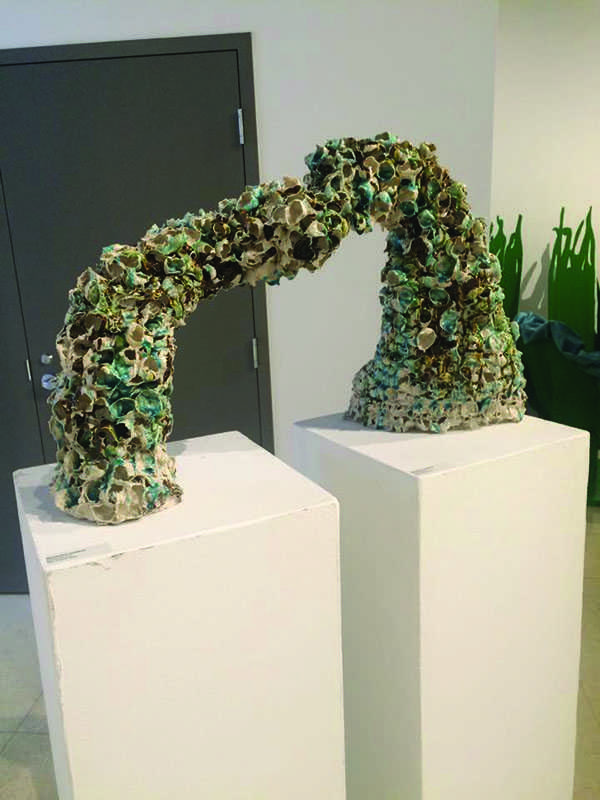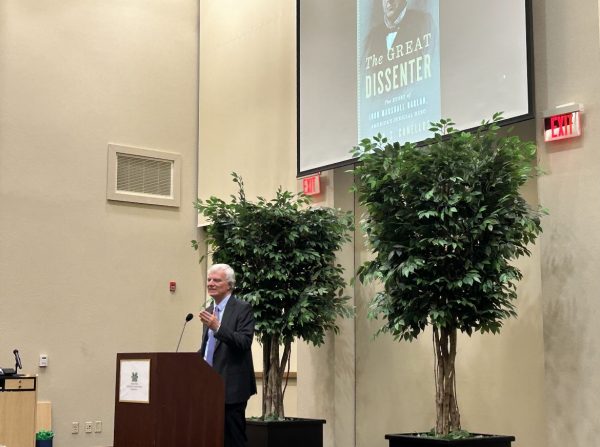for the sake of art
Current and former art students share joys, woes of art school
More stories from Karima Neghmouche
The Aristotle quote, “The aim of art is to represent not the outward appearance of things, but their inward significance,” can be represented in all artwork including creations made by previous and current Marshall University students.
Brett Marshall Tucker, finishing up his sculpting degree, said he creates art simply to show the inward significance in an easy, recognizable way.
“My work is more of a direct approach instead of the common nonobjective work that people read too much into,” Tucker said.
Tucker is working on his capstone, which shows two things being represented in a few different art mediums.
“Basically, there’s a black sheep and a martyr,” Tucker said. “Every family has a black sheep, and for the artist, it’s usually us. Then there’s the guy who works nine to five to feed his family. I wanted to create a physical version of these general stereotypes to not only try to understand them but capture those ideas and manifest them in a physical format.”
Tucker said he was introduced to clay work and sculpting after taking an art class that was required for his previous graphic design major.
“I liked hands on so much better than just sitting around on a computer,” Tucker said. “It’s like land and hand versus paperwork.”
Courtney Childers, ceramics major, also said she wanted something more than sitting in front of a computer.
“Last year, my sophomore year, I took my first ceramics class having never touched clay before, and I absolutely fell in love with it,” Childers said. “I realized that I couldn’t see myself happy sitting in front of a computer screen for the rest of my life, and I wanted something much more tangible and messy, very messy.”
Childers also said although she’s interested in photography and print-making, her favorite art medium is ceramics.
“I guess that’s expected,” Childers said. “I like the community it is involved with as well as the challenges and processes of making something from clay. Literally, you begin with dirt and make this thing that could be functional such as a mug that you can use for your coffee every day.”
Childers said the best part of art is she considers it playing instead of working, but it is a constant challenge.
“The worst part is that it is a constant challenge of self,” Childers said. “It’s hard when ideas and concepts don’t come easily or your time management is off. You are constantly pushing yourself both mentally and physically to meet deadlines and often expectations of self. Losing insight of making art for the sake of making art, or for fun, rather, is the worst. It becomes just another job when you get too wrapped up in deadlines and selling things.”
Sydney Griffith, a former Marshall student, said she has drawn for as long as she can remember.
“As a child, I always had my Minnie Mouse pencil case full of colored pencils and a legal pad with me wherever I went,” Griffith said.
Griffith said she loves working with acrylic paint but has explored art through a number of different mediums.
“I especially love painting portraits and projects that require a lot of shading,” Griffith said. It’s very relaxing to me to just put the world on mute for a few hours and lose myself in a painting,”
Griffith said she loves paint, but it is not her favorite work of art.
“My favorite is a group project that I did with Kelley Nesselroad, Ethan Wiles, and Lindsay Dieffenbach while studying fine art at West Virginia University,” Griffith said. “It’s a silhouette piece depicting the characters from Alice in Wonderland and Snow White engaging in battle. It was a very fun piece, and it encouraged us to be creative and throw a little humor into our work.”
Childers said she got her inspiration for one of her favorite pieces from a former Marshall student, Beth Ann Crutchfield.
“She inspired a project I did which included me dipping old stuffed animals from my childhood in slip to have the actual material and cotton stuffing burn out during the firing leaving me with only a shell of what I dipped in the slip,” Childers said. “I then rubbed colorants and glaze on each animal, hoping to convey a kind of foggy memory.”
Childers said she was inspired by Crutchfield’s capstone show, which included pieces involving a process of firing cotton balls and other materials such as twine or lace dipped in slip—a form of clay—and letting the cotton balls burn out in the kiln.
“This left a form that resembled an egg sack or broken egg shell,” Childers said. “She used a lot of runny glazes that seemed to pool in a lot of the shells, which was really lovely.”
Unlike Childers, other artists have outside inspirations.
“Inspiration, to me, comes from all over,” Griffith said. “It sounds cliché, but it’s true. Now that I am no longer an art student, I create purely for my own enjoyment. It’s all about having a good time.”
Tucker said the inspiration for his sculptures and characters come from characters he’s seen in movies, and characters he encounters on a day-to-day basis.
Childers said she partakes in other hobbies when she needs to decompress.
“I usually find myself collaging or making silly drawings in my spare time when I need a break from ceramics,” Childers said. “It’s a way to decompress from making conceptually heavy art that sometimes discusses difficult topics. The things I make during this downtime sometimes end up as actual ceramic pieces, so I guess it’s a good brainstorming technique. If I had to pick something not art related, it’s definitely something majorly boring, like hiking or reading a book: see also, long walks on the beach.”
Childers said a lot of her art seems to revolve around the concept of value, ownership and reflecting on memories.
Karima Neghmouche can be contacted at [email protected].
Your donation will help continue the work of independent student journalism at Marshall University. If you benefit from The Parthenon's free content, please consider making a donation.







